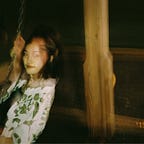Research Method
Reflection
Class Activity Reflection:
Unfortunately, I missed the class activity, but I tried it out with my parents, which turned out to be quite meaningful as well. I could tell that my parents felt a little awkward during the process. I guess each of us has a role to play when we are together as a family. The role or the mode of behavior and thoughts is shaped by the accumulation of all sorts of nuanced interactions with each other in the past. Ultimately we reached a balanced state as complementary elements, just like jigsaw puzzles. Because we already established a way to interact with each other that we are used to, it was hard to jump out of that pattern of conversation right away.
Research Method:
The research method I looked into was eye-tracking, which is a qualitative research technique that gathers detail technical information about where and for how long participants are looking when engaging with an interface or product. Specifically, it traces and documents the movements of fixation, which are areas in which a user’s gaze stops moving, lingering long enough for them to process what they’ve seen, and the rapid movement between fixation points, which is known as saccades. While fixations suggest which part took the user longer to process, saccades show the path the eyes are taking between fixations. The data could suggest many different aspects of an interface or product in detail. For example, the time taken to arrive at any given fixation could be related to how easy or difficult an element was to find.
Eyetracking is typically used in usability studies or the evaluative phase of human-computer interaction and product design. Think about the last time that you tried to open a package but could not find where to start with, ending up ripping it apart when you know there must be a better way to unpack it cleanly. This might not be your fault in the first place. In this case, designers could use the eye-tracking method to figure out which prototype of an amazon package box is the best by calculating the average time taken to find out the opening.
Eyetracking is a technology-enabled research method, and its precision is improving as new technology came along. Currently, most research uses optical methods to capture corneal reflections of infrared light on video using sophisticated cameras. New technology applies small sensing electrodes around the eyes, using electrical signals to precisely detect movements.
With Eyetracking data, designers could create heat maps using aggregated data, which result in a visual analysis of scan pattern and distributed attention. The heat map provides a color-coded reference for designers to analyze what feature of a product or interface attracted the most attention, and thus allows for better insights into human behavior and facilitates the design process for natural user interfaces. In other words, eye-tracking helps designers to see what the users see, literally.
Speed-dating Summary:
Round 1 with Alison
Body storming & Eye-tracking
These two methods can be paired together to measure design usability on large and small scales; eye tracking is typically used for smaller projects such as interface products, while body storming is good for large-scale dynamic interactions. Using both of these will ensure a more thorough thought process.
Round 3 with Caitlyn
Remote Moderated Research & Eye-tracking
Remote moderated research has a lot in common with eye tracking in the sense that the researcher only plays the role of a passive observer while the participants engage with the task on their own, but eye-tracking research mostly occurs in a lab and remote moderated research happens in the natural and personal setting, which narrows down the discrepancy between real-life behavior and the observed performance. Since more and more people moved their work and life online, their digital screen could reveal a lot about their behavior, which allows researchers to learn about the users. These two methods could be combined together to analyze a large amount of data of online users.
Round 3 with Catherine
Parallel Prototyping & Eye-tracking
In the third phase of parallel prototyping, a group of designers will join together and point out the things they like about each other’s prototype and find a way to synthesize them together. Eye-tracking is a great tool for usability tests and it is capable of aggregating a lot of data into one map to show patterns and hot spots of attention. I imagine that these two methods could serve as an evaluative approach for collaboration.
